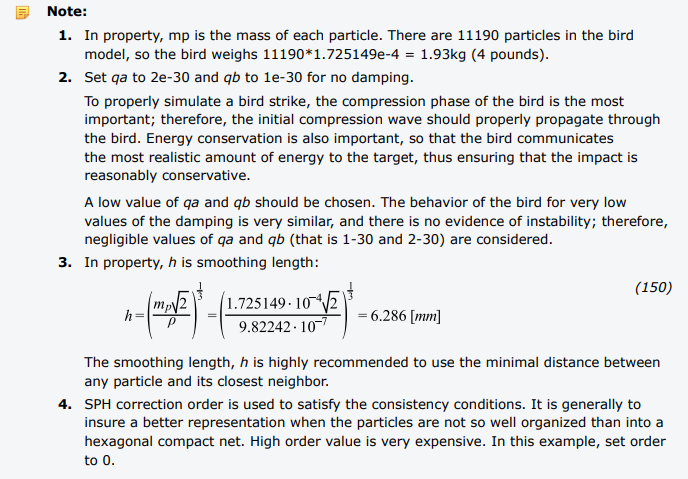Bird Strike Simulation Divergence
Probably a very basic error, but my bird strike simulation is diverging with a 99% energy error. Can anyone explain what I might have missed? I tried to follow the tutorial attached. but make it for my own purposes to implement composites later. Any suggestions would be appreciated.
Thanks in advance.
Hyperman, thanks for the answer. I'm not sure why this was happening, however. I thought if you leave gapmin blank it is automatically calculated?
Edit: Additionally, according to the model, gapmin=(6.35e-3m+7.5e-4m)/2=0.00355, but using that value messes up the simulation. In your model, you took the pitch of the SPH particles and used that as the gapmin instead. Furthermore, in a previous post, you mentioned that the elements should be 5-10 mm in size at most, however in your model, they are about 27.5 mm.
Edit 2: I also forgot to mention: some of the aspects of my model are also taken from the example problem in the reference manual, the windshield birdstrike demo.
I tried to translate it into a newer file, which is more efficient like yours attached here, but allows for a smaller element sizes. The thing is, I used almost exactly the same parameters you did, but my simulation still hit 99% error.
I also noticed you used qa=2.0 and qb=1.0. The tutorial recommends setting these values to a negligibly small value. Can you explain why not to follow that recommendation? For some reason, adhering to the demo causes divergence. For reference, this is in the 2019 reference manual:

Glad to help.
If gapmin is left blank it will be automatically calculated according to Igap flag. This value can be seen in starter out file by searching 'gapmin' keyword.
It appears the reason for 99% energy error after impact is a too high minimum gap for contact activation (gapmin) value- I have no explanation why this happens.
I have meshed the plate coarsely for computational efficiency during trial runs as we are more interested in SPH behavior than stress distribution- the final model should be refined according to mesh convergence study.
Actually, I haven't modified the linear and quadratic bulk viscosity (qa and qb) parameters- they were used in the model you shared.
Hyperman,
Thanks for all the help.
My mistake, I must have originally given a different file. The thing is, that the qa and qb values seem to be what is causing all the problems... I ran your original test1_edit_0000.rad file,which works just fine, but then changed the values of qa and qb to the very small values, and the simulation hit 99% error. I wasn't able to have a look at your Test2_edit_0000.rad, as it is a 2018 file, though looking through it, it seems that you only changed the qa and qb values. Did it run without divergence on your end?
The gapmin being so small is also very confusing. I noticed the same as you, that the gapmin appears to be activating the interface far too early... A gapmin at 0.00075 m is equivalent to the radius of the SPH particles, which means that the contact is activating well 'inside' the plate, considering that one half its thickness is 0.003175 m.
Attached is version 14 compatible model which ran fine on my end, regardless of qa and qb parameters.
Hyperman,
Sorry for the late reply. Just got around to taking a look at this. I still can't understand the instability in this model. I took your model and changed the speed from 80 m/s to 200 m/s, but this caused the energy error to hit 68%. Is there any reason for this?
Attached:
Test7 - 80 m/s
Test8 - 200 m/s
What factors could be playing into this? Is it that the speed is so high that the elements are distorting too much?
Hi,
as mentioned before, this positive energy is somehow due to the too high minimum gap. Reducing the gap to 4e-5 will make the model able to solve without positive energy.
Hi,
I gave that a try. It appears to work fine on my end too. I suppose my question is why exactly such a random guess for gapmin works (for which you said there's no explanation). Why 4e-5 m? And stranger yet, why does the appropriate gapmin work in the tutorial but not in this simulation? Is it the geometry? As I understand, now that the gapmin is so small, it basically means that the bird is interacting with the plate when it's well within the material, which physically makes no sense? I apologize if I'm getting annoying but I'm more concerned with trying to understand what's going on in the simulation, not specifically how to make it work.
Thanks,
Ayman
Hi,
the energy error is coming from the bird component as hourglass energy. One major difference is the bird in your example weighs 11 grams, while in the tutorial it weighs 1.93kg. Unfortunately, I am not familiar with SPH theory to figure this one out /emoticons/default_unsure.png' title=':unsure:' />

Hi,
There was an issue with gapmin. Please set /INTER/TYPE7 , GapMin= the 1/2 the pitch you used to generate the SPH particles + 1/2 the thickness of the walls. The pitch is the distance between the particles so 1/2 the pitch is the radius :
https://community.altair.com/community?id=community_question&sys_id=5a66003a1b2bd0908017dc61ec4bcbdfSimulation controls were defined and the plate was modified for computational efficiency. Finished model from birdstrike tutorial is also attached.
Unable to find an attachment - read this blog